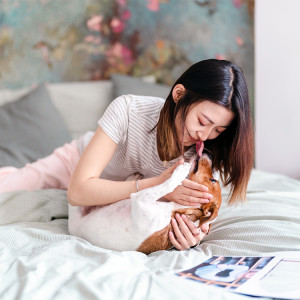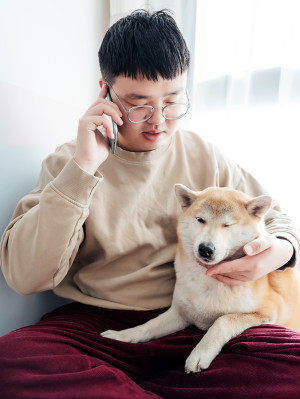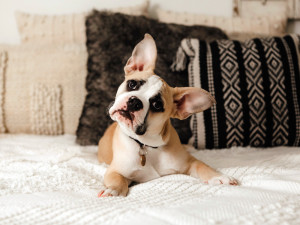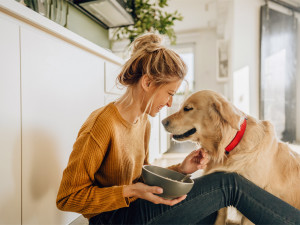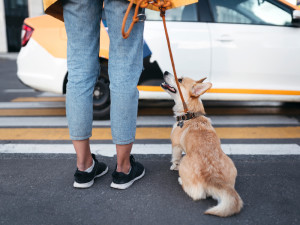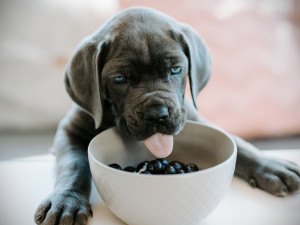Should I Let My Dog Eat Off My Plate?
What are the potential health implications for both humans and hounds?
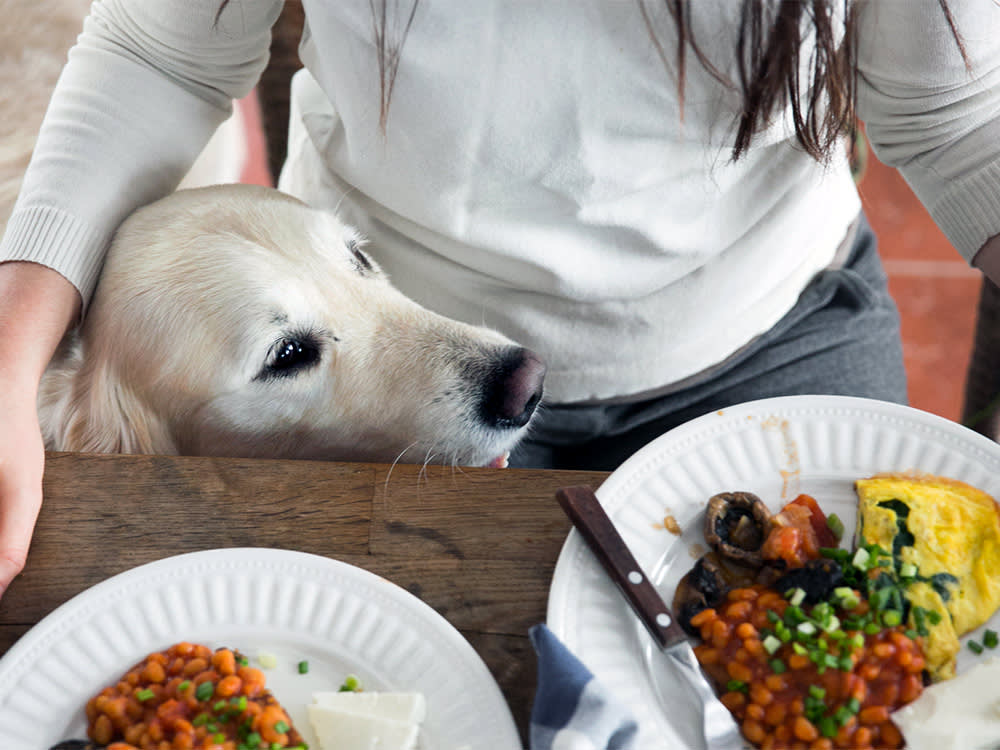
share article
As a nation of pet lovers, it’s not uncommon for furry companions to sit eagerly by the dinner table during meal times, their eyes fixed longingly on our plates as we eat. But as tempting as it may be to share a morsel or two with our four-legged friends, should we really be letting them eat off our plates?
The question of whether it’s safe to let your dog have a bite off our plate is a common dilemma; even celebrities can’t resist the pull of puppy dog eyesopens in a new tab when it comes to sneaking their dogs some food. Gemma Collins recently sparked a debate on social media after allowing her dog Blue to eat from her plate in a restaurant.
The former TOWIE star posted a video of Blueopens in a new tab eating her leftovers from her plate in a restaurant, but later had to apologise for triggering a “massive, massive storm” online, and agreed she shouldn’t have let her dog eat from her plate in hindsight, adding, “I just couldn’t resist blue having some scrambled eggs off my plate. I love the dog more than myself.” Don’t we all, GC. But is it a harmless gesture of love or a risky habit we should think twice about?
Let’s start with the basics. Allowing your dog to eat off your plate isn’t inherently harmful, but it’s not without its risks. Research by Wren Kitchensopens in a new tab found that one in six (15 percent) households in the UK let their pets lick their plates clean before putting them in the dishwasher, or washing them up – so if this is you, you’re not alone.
It’s a common misconceptionopens in a new tab that dogs have cleaner saliva than humans, but the truth is their mouths serve various purposes, such as eating, grooming and exploring, resulting in a delightful concoction of bacteria. Studies show a dog’s mouth can host over 600 types of bacteriaopens in a new tab, comparable to human saliva. While most aren’t transferable to humans, some, such as Salmonella, Pasteurella and Capnocytophaga, can cause skin infections and serious issues, especially in those with weakened immune systemsopens in a new tab.
Most household dishwashers are equipped with high temperatures and powerful detergents that are effective at killing germs and bacteria, but a dog’s saliva can also contain harmful bacteriaopens in a new tab to humans that we can’t always be sure is 100 percent removed after washing. Better to be safe than sorry, and leave the cleaning to the professionals.
Let’s address the elephant in the room (or should I say, the dog under the table): dining out with your dog. Whilst the idea of sharing your meal with your canine companion might seem like a delightful bonding experience for some, it’s probably best to leave the fine dining to humans, especially when out and about. Not only is it considered poor etiquette in most establishments, but it can also pose potential health risks for your pet.
Allowing your dog to eat off your plate in a restaurant setting can expose them to harmful potential food hazards. Human foods, in particular those from restaurants, have a high salt content which can be damaging to dogs.
Whilst dogs can generally handle a lot of human foodsopens in a new tab, some can be harmful or even toxic to them, so it’s best to avoid letting them lick plates that have come into contact with potentially harmful substancesopens in a new tab such as chocolate, grapes, onions or garlic. If you’re not in the kitchen yourself, that’s harder to do, as it includes keeping your pup free of sauces that might contain toxic ingredients, no matter how cute their puppy eyes are.
But what about the age-old debate of whether to put your plate on the floor after finishing your meal? As tempting as it may be to let your dog join you at the table, it’s important to establish boundaries with your pup. While it might seem like a kind gesture, it’s not necessarily the most effective or humane approach to managing your pet’s behaviour, and the answer depends entirely on your individual dog, says Katie Lottopens in a new tab, a dog trainer who has been training dogs and fostering difficult pups for over two years.
“If you are actively working on training with your dog (whether that is reactivity, recall, loose lead or tricks), you want to use all your dog’s daily food allowance for training and make sure they are fully motivated to eat when they are out training on walks,” she explains.
On the other hand, “If your dog is a fussy or picky eater – you don’t want them refusing their own food because they’d rather wait for any human table scraps!” adds Katie. “Equally, if your dog has ever shown any signs of resource guarding in the past, I would not be letting them lick from a plate, and would only hand feed as it creates the positive associations that: food comes from humans – you don’t need to guard.”
But (and that’s a big but). “If you are one of the lucky few who’s dog will always want to work for food (whether it is a crumb of kibble or a lick of gravy) then it’s fine to let your dog help clean the dishes!” she adds.
So, as with many of these questions, the answer to whether you should let your dog eat off your plate ultimately depends on your individual circumstances and preferences. Whilst it may be tempting to indulge your dog’s desire to share in your mealtime experience, it’s important to prioritise their health and safety above all else.
When dining out, opt for pet-friendly treats instead of sharing human food, and at home, ensure that any plates your dog comes into contact with are thoroughly cleaned and free of potentially harmful substances. Hopefully, with a little bit of caution and common sense, you can ensure that meal times remain a safe and enjoyable experience for both you and your furry friend.

Orla Pentelow
Orla Pentelow is a freelance journalist and copywriter based in London. When not at her desk she’s out and about with her rescue dog, Luna, who works primarily as chief distractor.
Related articles
![A woman smiling at her dog while carrying a bowl of food.]() opens in a new tab
opens in a new tabIs Yoghurt Good For Your Dog?
It’s safe and healthy, and most dogs love it
![weird dog rolling in poop]() opens in a new tab
opens in a new tab7 Weird Dog Behaviours Explained
Chasing their tails, eating grass and rolling in rubbish – should you worry?
![Dog looks up at owner on a walk through the city]() opens in a new tab
opens in a new tab7 Ways to Stop Your Dog From Scavenging On Walks
If your dog tries to wolf down literally everything in sight, you need this advice
![Puppy eating a bowl of blueberries]() opens in a new tab
opens in a new tab10 Superfoods to Share With Your Dog
From kale to quinoa, these nutrient-packed picks deserve a spot in your dog’s food bowl
